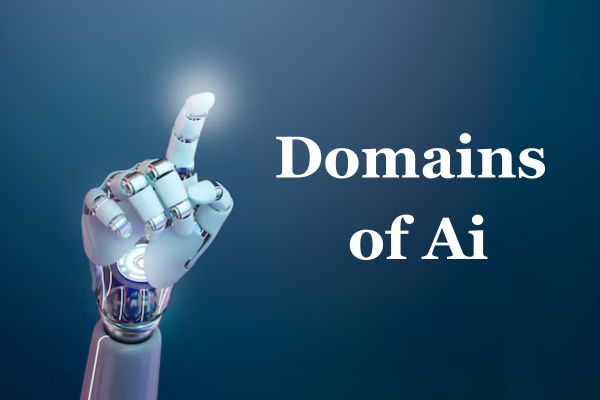The vast field of AI is categorized into multiple domains, each catering to specific problem-solving techniques and applications. Understanding these domains provides a comprehensive look into the capabilities and impact of AI in the modern world.
Also See: 30 Benefits of AI (Artificial Intelligence) in Cyber Security
1. Machine Learning (ML)
Machine Learning is one of the most prominent branches of AI. It involves creating algorithms that enable systems to learn from data, identify patterns, and make decisions with minimal human intervention. ML is divided into three key categories:
- Supervised Learning: Models learn from labeled data, making predictions based on past examples. Example: Email spam detection.
- Unsupervised Learning: Algorithms detect hidden patterns in unlabeled data. Example: Customer segmentation.
- Reinforcement Learning: AI agents interact with an environment, receiving rewards or penalties to optimize their actions. Example: Self-driving cars.
Real-world Application: Fraud Detection
Banks and financial institutions use ML algorithms to detect fraudulent transactions by identifying unusual spending behaviors and flagging suspicious activities.
2. Natural Language Processing (NLP)
NLP is the domain of AI that focuses on the interaction between computers and human language. It enables machines to understand, interpret, and generate text in a way that is both meaningful and useful.
Also See: 31+ Artificial Intelligence Benefits to Society: AI Contribution
Key Aspects of NLP:
- Text Processing: Tokenization, stemming, and lemmatization to break text into meaningful units.
- Sentiment Analysis: Understanding emotions behind words to gauge opinions in reviews and social media.
- Machine Translation: AI-powered tools like Google Translate break language barriers.
- Chatbots & Virtual Assistants: Siri, Alexa, and ChatGPT use NLP to process and respond to user queries effectively.
Real-world Application: Customer Support Automation
Companies implement AI-powered chatbots to provide instant responses, reducing wait times and improving customer experience.
3. Computer Vision
Computer vision enables AI to interpret and process visual data. It allows machines to analyze images, recognize objects, and even comprehend complex scenes.
Key Applications:
- Facial Recognition: Used in security systems and social media tagging.
- Medical Imaging Analysis: AI assists in diagnosing diseases by analyzing X-rays and MRI scans.
- Autonomous Vehicles: Self-driving cars use computer vision to detect obstacles and navigate roads safely.
Real-world Application: Healthcare Diagnostics
AI-powered computer vision helps doctors detect tumors, fractures, and other anomalies in medical scans with high accuracy.
Also See: What Purpose do Fairness Measures serve in AI Product Development
4. Expert Systems
Expert systems are designed to mimic human decision-making using a knowledge base and inference rules. These systems provide solutions to complex problems by analyzing available data.
Key Components:
- Knowledge Base: Stores domain-specific facts and rules.
- Inference Engine: Applies logical reasoning to derive conclusions.
Real-world Application: Medical Diagnosis
AI-powered expert systems assist doctors in diagnosing diseases by analyzing symptoms and recommending treatment options.
5. Robotics
AI-driven robotics integrates machine learning, computer vision, and control systems to build intelligent machines capable of performing tasks autonomously.
Key Applications:
- Industrial Automation: Robots assemble products with high precision in manufacturing.
- Healthcare Assistance: Robotic arms assist in surgeries, ensuring precision.
- Space Exploration: AI-powered robots like NASA’s Perseverance rover explore Mars.
Real-world Application: Robotic Process Automation (RPA)
Companies use RPA to automate repetitive tasks like data entry and invoice processing, boosting productivity.
6. Fuzzy Logic
Fuzzy logic deals with reasoning that is approximate rather than fixed and exact. Unlike traditional binary logic (true/false), fuzzy logic allows AI systems to handle uncertainty.
Key Applications:
- Smart Home Systems: AI adjusts room temperature based on fuzzy logic.
- Consumer Electronics: Washing machines optimize washing cycles based on dirt levels.
- Automotive Systems: Anti-lock braking systems (ABS) enhance driving safety.
Real-world Application: AI-driven Climate Control
Fuzzy logic enables air conditioners to adjust cooling intensity based on room occupancy and external temperatures.
Comparing AI Domains
The table below provides a quick comparison of AI domains based on key characteristics:
| Domain | Focus Area | Real-world Example |
|---|---|---|
| Machine Learning | Data-driven pattern recognition | Fraud detection in banking |
| NLP | Understanding human language | AI chatbots & virtual assistants |
| Computer Vision | Image and video analysis | Medical image diagnostics |
| Expert Systems | Decision-making automation | AI-powered medical diagnosis |
| Robotics | Autonomous physical tasks | Industrial automation |
| Fuzzy Logic | Handling uncertainty | Smart home systems |
Conclusion
Artificial Intelligence spans multiple domains, each contributing uniquely to advancements in technology. From machine learning’s predictive power to NLP’s language comprehension and robotics’ automation capabilities, AI continues to shape our world. Understanding these domains helps businesses, researchers, and individuals leverage AI’s potential to drive innovation and efficiency.
